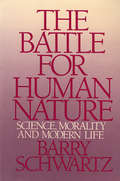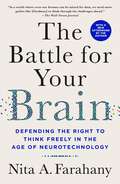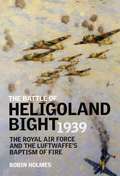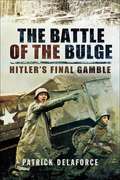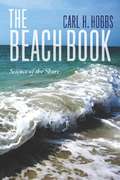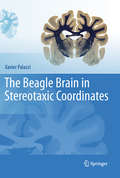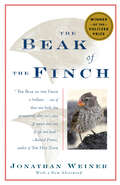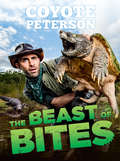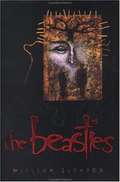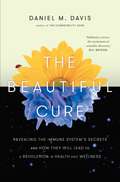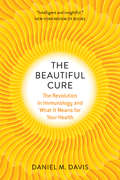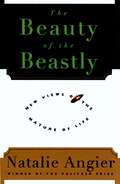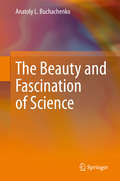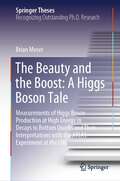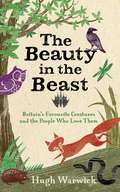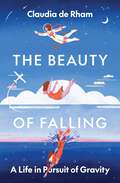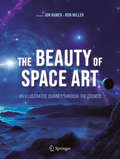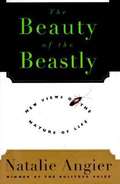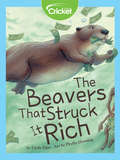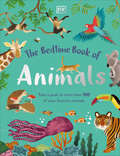- Table View
- List View
The Battle for Human Nature: Science, Morality and Modern Life
by Barry Schwartz"Provocative and richly textured. . . .Schwartz's analyses of the inadequacies of contemporary scientific views of human nature are compelling, but the consequences are even more worthy of note." --Los Angeles Times Out of the investigations and speculations of contemporary science, a challenging view of human behavior and society has emerged and gained strength. It is a view that equates "human nature" utterly and unalterably with the pursuit of self-interest. Influenced by this view, people increasingly appeal to natural imperatives, instead of moral ones, to explain and justify their actions and those of others.
The Battle for Your Brain: Defending the Right to Think Freely in the Age of Neurotechnology
by Nita A. FarahanyA new dawn of brain tracking and hacking is coming. Will you be prepared for what comes next?Imagine a world where your brain can be interrogated to learn your political beliefs, your thoughts can be used as evidence of a crime, and your own feelings can be held against you. A world where people who suffer from epilepsy receive alerts moments before a seizure, and the average person can peer into their own mind to eliminate painful memories or cure addictions.Neuroscience has already made all of this possible today, and neurotechnology will soon become the “universal controller” for all of our interactions with technology. This can benefit humanity immensely, but without safeguards, it can seriously threaten our fundamental human rights to privacy, freedom of thought, and self-determination.From one of the world’s foremost experts on the ethics of neuroscience, The Battle for Your Brain offers a path forward to navigate the complex legal and ethical dilemmas that will fundamentally impact our freedom to understand, shape, and define ourselves.
The Battle of Heligoland Bight 1939: The Royal Air Force and the Luftwaffe's Baptism of Fire
by Robin HolmesThis illustrated history chronicles the first British bombing raid of WWII and the early lessons learned about strategic bombing. On the 4th of September 1939, Squadron Leader Paul Harris led 149 Squadron to Brunsbüttel, Wilhelmshaven in a Vickers Wellington Mk. 1 medium bomber. On the way he ordered that the guns of his airplane be tested, only to make the horrifying discovery that not one of them worked. Though he was flying completely defenseless, he chose to press on. On the 18th of December, Harris flew to Wilhelmshaven once again and took part in the Battle of Heligoland Bight, the first major encounter between the Royal Air Force and the Luftwaffe. This time he flew a Wellington Mk.1A—codenamed &“R&” for Robert—and his guns were red hot and ready. Of all the Wellington bombers that fought the Luftwaffe, Paul Harris&’ old Wimpy is the only one left, preserved at the Brooklands Museum in Weybridge, England.
The Battle of the Bulge: Hitler's Final Gamble
by Patrick DelaforceBy late 1944 the Allies were poised to smash the Siegfried Line and break into Germany. Supply lines were shorter thanks to the port of Antwerp. Arnhem aside, there had been a long run of victories and there was no intelligence even from ULTRA to suggest a German counter-offensive.So the major December attack through the mountainous Ardennes by massed Panzers and infantry took the Allies totally by surprise. Fog and low cloud negated the Allies' air supremacy, English-speaking German commandos in captured jeeps created panic and withdrawal of US forces became a near rout with morale all but broken.For ten days the situation worsened and Antwerp was seriously threatened and 21st Army Group in danger of being cut off.Clear skies for the Thunderbolts and coherent counter-attacks by rapidly deployed reinforcements turned the tide in the nick of time, so preventing a catastrophic defeat for the Allies.All this and more is graphically narrated in this fine study of a pivotal battle, that so nearly changed the course of war.
The Beach Book: Science of the Shore
by Carl HobbsWaves and tides, wind and storms, sea-level rise and shore erosion: these are the forces that shape our beaches, and beach lovers of all stripes can benefit from learning more about how these coastal processes work. With animation and clarity, The Beach Book tells sunbathers why beaches widen and narrow, and helps boaters and anglers understand why tidal inlets migrate. It gives home buyers insight into erosion rates and provides natural-resource managers and interested citizens with rich information on beach nourishment and coastal-zone development. And for all of us concerned about the long-term health of our beaches, it outlines the latest scientific information on sea-level rise and introduces ways to combat not only the erosion of beaches but also the decline of other coastal habitats. The more we learn about coastline formation and maintenance, Carl Hobbs argues, the better we can appreciate and cultivate our shores. Informed by the latest research and infused with a passion for its subject, The Beach Book provides a wide-ranging introduction to the shore, and all of us who love the beach and its associated environments will find it timely and useful.
The Beagle Brain in Stereotaxic Coordinates
by Xavier PalazziThis is an up-to-date atlas of the stereotaxic coordinates of the beagle brain. It provides stellar illustrations of the organization of nerve tracts and the morphology of the nuclei that compose the central nervous system.
The Beak of the Finch: A Story of Evolution in Our Time (Pulitzer Prize Winner)
by Jonathan WeinerPULITZER PRIZE WINNER • A dramatic story of groundbreaking scientific research of Darwin's discovery of evolution that "spark[s] not just the intellect, but the imagination" (Washington Post Book World). &“Admirable and much-needed.... Weiner&’s triumph is to reveal how evolution and science work, and to let them speak clearly for themselves.&”—The New York Times Book ReviewOn a desert island in the heart of the Galapagos archipelago, where Darwin received his first inklings of the theory of evolution, two scientists, Peter and Rosemary Grant, have spent twenty years proving that Darwin did not know the strength of his own theory. For among the finches of Daphne Major, natural selection is neither rare nor slow: it is taking place by the hour, and we can watch.In this remarkable story, Jonathan Weiner follows these scientists as they watch Darwin's finches and come up with a new understanding of life itself. The Beak of the Finch is an elegantly written and compelling masterpiece of theory and explication in the tradition of Stephen Jay Gould.
The Bear Went Over the Mountain: Soviet Combat Tactics in Afghanistan
by Lester W. GrauAuthor has made an attempt to draw general conclusions about the little-investigated experiences in the training and the conduct of combat which were influenced by Afghanistan experience. These include specific mission decisions involving blocking and destroying guerrilla forces, etc.
The Bear's Nature Guide
by Stan Berenstain Jan BerenstainFrom the book: Almost everything small bears and kids need to know about... the animals the plants the earth itself with actual facts about frogs, possums, birds, fish, trees, rocks, ladybugs, earthquakes.... and lots more
The Beast of Bites (Brave Wilderness)
by Coyote PetersonAnimal Planet star and Emmy Award-winning host of YouTube's Brave Wilderness Coyote Peterson is back, and this time he's being BITTEN by some of Earth's wildest beasts in this full-color adventure, perfect for fans of The King of Sting and all animal enthusiasts.In The Beast of Bites, Coyote chronicles his most memorable--and painful--bites from his wildest animal encounters seen on the Brave Wilderness YouTube channel. Coyote faces everything from snapping turtle chomps to the horrific, venomous grasp of a giant desert centipede. Featuring photographic stills from episodes, original full-color illustrations, and packed with facts about nature's most misunderstood creatures, this is a dream book for any kid that loves animals, the great outdoors, and daringly dangerous adventures!
The Beasties
by William SleatorThe master of suspense delivers a hard-core horror story to thrill and chill. Fans will get more than goosebumps from this terrifying tour de force by William Sleator. The nightmare begins when Doug's family moves to the desolate northern woods; soon he and his little sister, Colette, become caught up in a war between the area's loggers and a dying race of woodland creatures who depend on human body parts for their survival. Tunnels, tunnels, leading everywhere... even right into Doug and Colette's basement. But who built them? Could the rumors about the mysterious, bloodthirsty kidnappers called the Beasties possibly be true? Skeptical Doug doesn't buy it at first, even if an unusual number of the local inhabitants seem to be missing important pieces of their anatomies. But once he and his sister stumble into a cavernous opening and meet the Beastie scout named Fingers, Doug is forced to become a believer. Colette soon is indoctrinated into the society of the Family, an underground civilization of slimy, pale beings with crudely stitched-together body parts. Doug desperately hopes to remain an outsider, but it seems he has no choice. In fact, the Family needs him to make the biggest sacrifice of all. If he tries to escape, he faces an awful truth (one that readers, too, will learn): Once you have met the Beasties, you will never be safe again.
The Beasts that Hide from Man: Seeking the World's Last Undiscovered Animals
by Karl P. ShukerCryptozoology--the study of hidden animals--is gaining attention thanks to a startling number of zoological discoveries. Karl P.N. Shuker has collected evidence of these mysterious, somewhat mythical creatures in The Beasts that Hide from Man. Shuker provides entertaining, solidly researched tales about extraordinary animals. Shuker also provides a supplement to Bernard Heuvelmans's checklist of cryptozoological animals, which contains updated information on unknown creatures.
The Beauties and The Beasts: Creatures At the Bottom of the Ocean
by Betty PfeifferWhen do you know someone best? When you read their biography or when you have a conversation with them? Of course, it&’s when you have a one-on-one visit. Go down in a submersible, the HOV (Human Occupied Vehicle) Alvin, to make the journey to their home. You&’ll meet the weird, the cute, the flashy, and the fierce creatures of the deep.In this book, you won&’t just read a bunch of facts about these remarkable animals—you can learn to know them personally. They&’ll talk to you about themselves, their relatives, and their enemies. As a surprise bonus, you will find out about the many ways your new friends are helping us solve some of our medical problems.Suppose you are interested in learning more about what happens in the ocean. In that case, two people (real people) will tell you what they were like at your age and what motivated them to make the ocean, which covers about 70 percent of the earth&’s surface, their life&’s work.
The Beautiful Cure: Revealing the Immune System's Secrets and How They Will Lead to a Revolution in Health and Wellness
by Daniel M. DavisA leading expert explains how discoveries about the immune system are leading the way to a revolution in beating cancer and other diseases.The immune system holds the key to human health. The scientific quest to understand how it works--and how it is affected by stress, diet, sleep, age, exercise and our state of mind--is now unlocking a revolutionary new approach to medicine and well-being. The body's ability to fight disease and heal itself is one of the great mysteries and marvels of nature, but within the last few years, painstaking research has resulted in major advances in our understanding of the immune system, revealing an inner world of breathtaking sophistication, complexity and beauty. Far more powerful than any medicine ever invented, it also plays a crucial role in our daily lives. Already we have found ways to harness these natural defences to create break-through drugs and therapies that can beat cancer, diabetes, arthritis and many age-related diseases, and we are starting to understand how activities such as mindfulness might play a role in enhancing our physical resilience. Written by an expert at the forefront of this adventure, The Beautiful Cure tells a dramatic story of detective work and discovery, of puzzles solved and of the mysteries that remain, of lives sacrificed and saved, introducing the reader to this revelatory new understanding of the human body and what it takes to be healthy.
The Beautiful Cure: The Revolution in Immunology and What It Means for Your Health
by Daniel M. Davis&“A terrific book by a consummate storyteller and scientific expert considers the past and future of the body&’s ability to fight disease and heal itself.&” —Adam Rutherford, The Guardian The immune system holds the key to human health. In The Beautiful Cure, leading immunologist Daniel M. Davis describes how the scientific quest to understand how the immune system works—and how it is affected by stress, sleep, age, and our state of mind—is now unlocking a revolutionary new approach to medicine and well-being. The body&’s ability to fight disease and heal itself is one of the great mysteries and marvels of nature. But in recent years, painstaking research has resulted in major advances in our grasp of this breathtakingly beautiful inner world: a vast and intricate network of specialist cells, regulatory proteins, and dedicated genes that are continually protecting our bodies. Far more powerful than any medicine ever invented, the immune system plays a crucial role in our daily lives. We have found ways to harness these natural defenses to create breakthrough drugs and so-called immunotherapies that help us fight cancer, diabetes, arthritis, and many age-related diseases, and we are starting to understand whether activities such as mindfulness might play a role in enhancing our physical resilience. Written by a researcher at the forefront of this adventure, The Beautiful Cure tells a dramatic story of scientific detective work and discovery, of puzzles solved and mysteries that linger, of lives sacrificed and saved. With expertise and eloquence, Davis introduces us to this revelatory new understanding of the human body and what it takes to be healthy. &“Visceral.&” —The Wall Street Journal &“Illuminating.&” —Publishers Weekly &“Heroic.&” —Science
The Beauty Of The Beastly: New Views on the Nature of Life
by Natalie AngierNatalie Angier knows all that scientists know - and sometimes more - about the power of symmetry in sexual relations, about the brutal courting habits of dolphins, about the grand deceit of orchids, about the impact of female and male preferences on evolution. She knows how scientists go about their work, and she describes their ways, their visions, and their arguments. Perhaps most poignantly, she understands the complexities and the sad necessity of death. "The beauty of the natural world lies in the details, and most of those details are not the stuff of calendar art," she points out. Few writers have ever covered so many facets of biology so evocatively in one book. The Beauty of the Beastly tells us how the genius of the biological universe resides in its details and proves why, according to Timothy Ferris, author of the acclaimed Coming of Age in the Milky Way, Angier is "one of the strongest and wittiest science writers in the world today."
The Beauty and Fascination of Science
by Anatoly L. BuchachenkoIn this book, Professor Anatoly Buchachenko gives a brief and informative description of the most striking achievements and discoveries made in the major natural sciences at the turn of the century – in the late twentieth and early twenty-first centuries. The author has a rare ability to describe scientific discoveries so that these achievements and their significance are understandable not only by professionals and scientists of all specialities, but for any reader interested in modern science, its role in the existence of mankind, and its impact on human society. Originally published in Russian, Professor Buchachenko’s book describes the interaction of natural sciences with social ones—philosophy and history—as well as the part played by the human factor in the development of science, especially the role of the great scientists.
The Beauty and the Boost: Measurements of Higgs Boson Production at High Energy in Decays to Bottom Quarks and Their Interpretations with the ATLAS Experiment at the LHC (Springer Theses)
by Brian MoserPrecision measurements of the Higgs boson’s properties are a powerful tool to look for deviations from the predictions of the Standard Model (SM) of particle physics. The 139/fb of proton-proton collision data which have been collected by the ATLAS experiment during Run 2 of the LHC, offer an opportunity to investigate rare Higgs-boson topologies, which are particularly sensitive to new physics scenarios but experimentally difficult to access. Several such measurements, which target Higgs-boson decays to heavy-flavour quarks, as well as their combinations are presented in this thesis. A novel analysis that measures Higgs-boson production in association with a heavy vector boson V (VH, with V=W,Z) at high energies is presented. Dedicated Higgs-boson reconstruction techniques are applied to reconstruct the highly Lorentz-boosted Higgs-boson decays into pairs of bottom quarks. The measurement is subsequently combined with a VH cross-section measurement at low and intermediate pT(V) to provide a differential cross-section measurement in kinematic fiducial volumes over the largest possible pT(V) range. All cross-section measurements agree with the SM predictions within relative uncertainties that range from 30% to 300%. The results are furthermore interpreted as limits on the parameters of a SM effective field theory. Finally, a combination of measurements of Higgs decays to heavy-flavour quarks is used to experimentally determine that the Higgs-boson coupling to charm quarks is weaker than to bottom quarks, as predicted by the SM. The target audience for the thesis are physicists and physics students, in particular those with a background in high energy physics.
The Beauty in the Beast: Britain's Favourite Creatures and the People Who Love Them
by Hugh WarwickA delightful portrait of some of the UK's best-loved wild animals and birds and the colourful enthusiasts who champion their causes.
The Beauty of Chemistry: Art, Wonder, and Science
by Philip BallImages and text capture the astonishing beauty of the chemical processes that create snowflakes, bubbles, flames, and other wonders of nature.Chemistry is not just about microscopic atoms doing inscrutable things; it is the process that makes flowers and galaxies. We rely on it for bread-baking, vegetable-growing, and producing the materials of daily life. In stunning images and illuminating text, this book captures chemistry as it unfolds. Using such techniques as microphotography, time-lapse photography, and infrared thermal imaging, The Beauty of Chemistry shows us how chemistry underpins the formation of snowflakes, the science of champagne, the colors of flowers, and other wonders of nature and technology. We see the marvelous configurations of chemical gardens; the amazing transformations of evaporation, distillation, and precipitation; heat made visible; and more.
The Beauty of Falling: A Life in Pursuit of Gravity
by Claudia de RhamA world-renowned physicist seeks gravity&’s true nature and finds wisdom in embracing its force in her lifeClaudia de Rham has been playing with gravity her entire life. As a diver, experimenting with her body&’s buoyancy in the Indian Ocean. As a pilot, soaring over Canadian waterfalls on dark mornings before beginning her daily scientific research. As an astronaut candidate, dreaming of the experience of flying free from Earth&’s pull. And as a physicist, discovering new sides to gravity&’s irresistible personality by exploring the limits of Einstein&’s general theory of relativity. In The Beauty of Falling, de Rham shares captivating stories about her quest to gain intimacy with gravity, to understand both its feeling and fundamental nature. Her life&’s pursuit led her from a twist of fate that snatched away her dream of becoming an astronaut to an exhilarating breakthrough at the very frontiers of gravitational physics.While many of us presume to know gravity quite well, the brightest scientists in history have yet to fully answer the simple question: what exactly is gravity? De Rham reveals how great minds—from Newton and Einstein to Stephen Hawking, Andrea Ghez, and Roger Penrose—led her to the edge of knowledge about this fundamental force. She found hints of a hidden side to gravity at the particle level where Einstein&’s theory breaks down, leading her to develop a new theory of &“massive gravity.&” De Rham shares how her life&’s path turned from a precipitous fall to an exquisite flight toward the discovery of something entirely new about our surprising, gravity-driven universe.
The Beauty of Space Art: An Illustrated Journey Through the Cosmos
by Ron Miller Jon RamerLong before humans wrote, we painted.From mud and ash to acrylic and computers, artists across the centuries have found countless inventive ways to explore and express some of life’s biggest mysteries. Enter space art, a genre of artistic expression that strives to capture the wonders of our universe. This lavishly illustrated book chronicles the remarkable development of space art from a fledgling theme to a modern movement.In Part I, we traverse the history of art and astronomy from ancient times, through the Industrial Revolution, and into the 20th-century Space Age. Part II delves into the diverse techniques and subgenres of space art, where you will learn about things like rocks and balls, hardware art, and cosmic expressionism. Along the way, we’ll stop at places where neither humans nor spacecraft can easily go, from the scorching surface of Venus and the radiation-soaked volcanoes of Io to the alien terrain of exoplanets and the depths of distant galaxies.Featuring hundreds of original color images from space artists and astronomers alike, this book is a vivid visual story about the power of art, astronomy, and human curiosity. A heavily revised edition of the original Beauty of Space, it will entertain, educate, and inspire anybody who yearns to make sense of the strange and surreal sights in our universe.
The Beauty of the Beastly: New Views on the Nature of Life
by Natalie AngierNatalie Angier, one of the foremost American science writers, is the author of the masterly book "Natural Obsessions: The Search for the Oncogene (1988)". Now, in "The Beauty of the Beastly", she has reshaped many of her daily and weekly articles into a narrative that vividly conveys the discoveries of contemporary biological science and how biologists made them. She has arranged her topics according to the energy from which they spring - the life forces that inform and energize her (and our) work. To Angier, the movement, the dance, the play of life supplies the heartbeat of knowledge. In seven sections entitled, in order: Loving, Dancing, Slithering, Adapting, Healing, Creating, and Dying; Angier focuses on what science knows about the living world, in her own witty and exalted language.
The Beavers That Struck It Rich
by Linda ZajacWhat good is money to a beaver? In this amazing yet true story, wild beavers build their dam using stolen money that was discard into a creek. While the authorities scoured the area for the cash, the beavers incorporated the bills into their dam.
The Bedtime Book of Animals (The Bedtime Books)
by DKA must-have illustrated introduction to the animal kingdom, including over 50 of the world&’s favorite animals! Introducing The Bedtime Book of Animals, a must-have animal reference book for all early readers who are keen to explore animals from all over the globe. Turn each page to find out more about a wide variety of animals, from teeny-tiny insects to gigantic elephants and whales. The Bedtime Book of Animals showcases creatures from each of the core animal groups (mammals, birds, reptiles, amphibians, fish, and invertebrates) in six dedicated chapters. Many pages are devoted to a different creature, with others featuring a collection of animals from the same family, and some explore more than one animal type, giving bite-sized chunks of accessible information to help early learners get to know new species.A fun-filled journey into the animal kingdom awaits you, promising: - A must-have introduction to a wide variety of animals from around the world- Introduces essential information about each species in a friendly, accessible way- Colorfully illustrated, with light annotation of key features- Reinforces early animal vocabulary, and builds awareness of connections in the animal kingdom- Fully illustrated, with a bright color palette and fresh feel. From rabbits and red pandas, starfish to songbirds, The Bedtime Book of Animals is a beautiful, fully-illustrated and, engaging picture book with read-alout text– perfect for parents/carers and children to enjoy at bedtime. A must-have volume to add to every 3-5 year old&’s library, this is a one-hit introduction to animals, featuring more than 50 best-loved and lesser-known animals from around the world. Did you know that the topic of animals is universally popular and this is a tried-and-tested non-fiction genre, which can help to develop early understanding of the natural world in young readers, as well as develop soft skills such as empathy, kindness and care in 3-5-year-olds? Perfect for parents and educators seeking to introduce core animal knowledge at a young age, including how to recognize animals, animal categorization and key features. A friendly, factual, timeless gift book, The Bedtime Book of Animals will be treasured forever.
